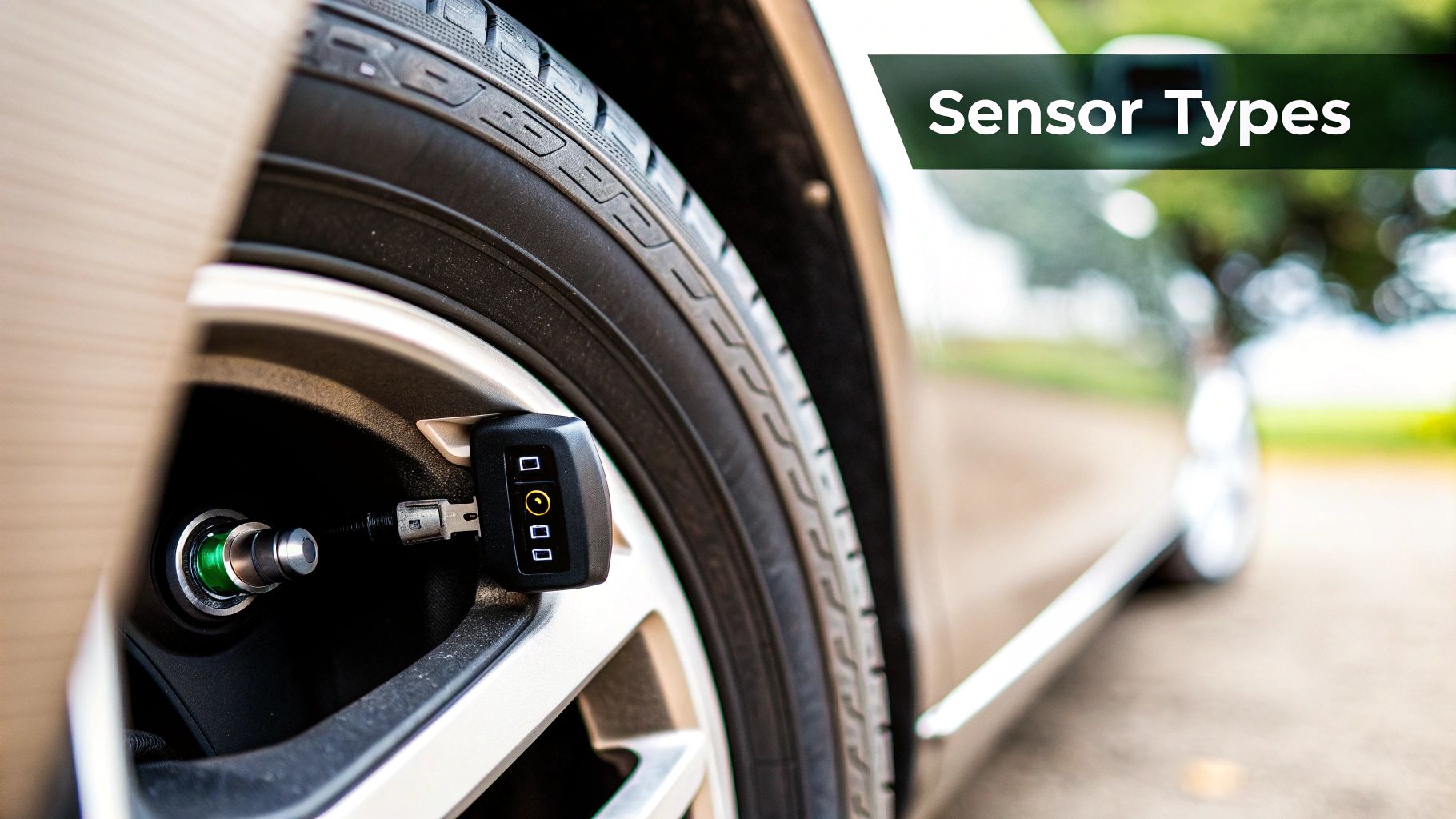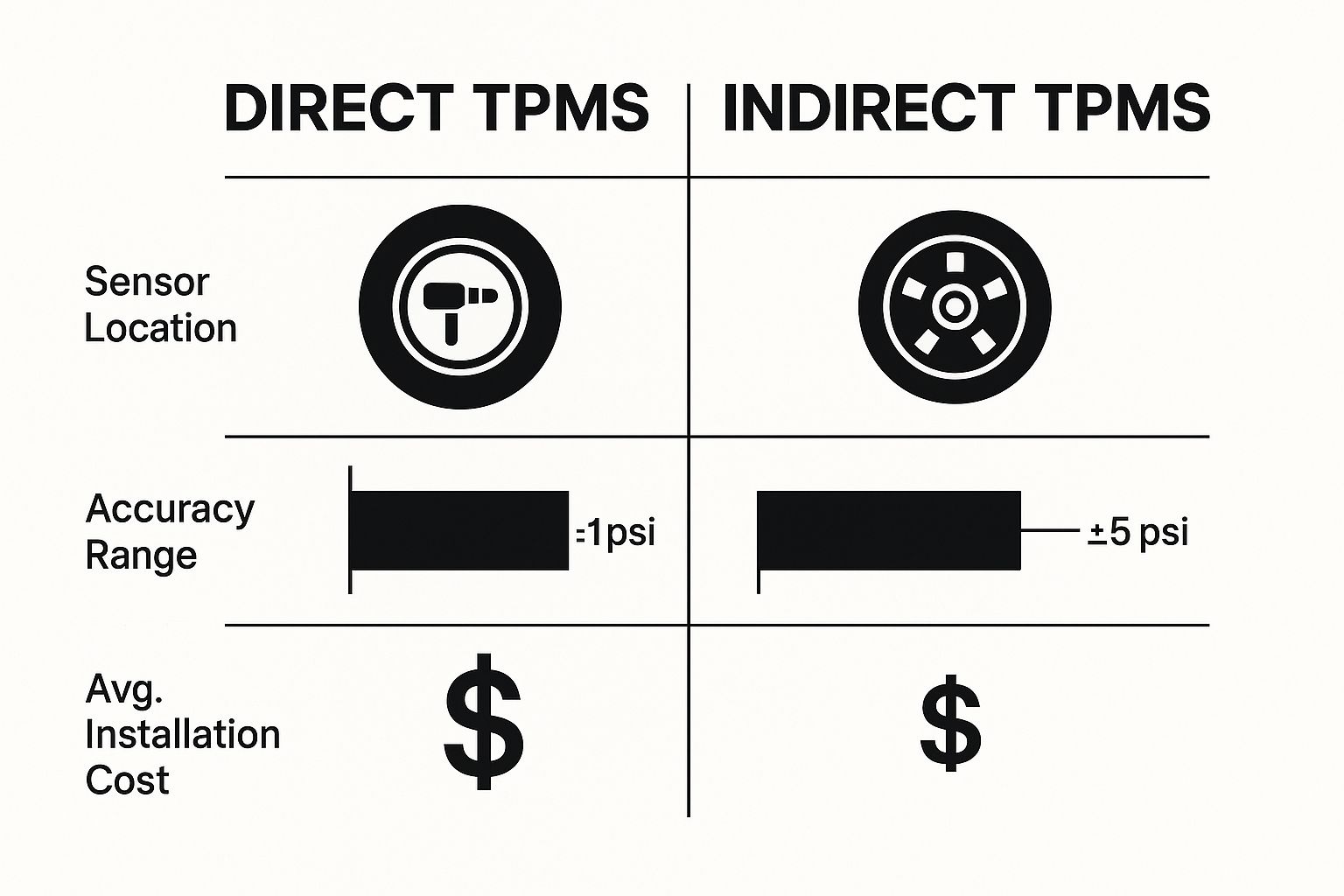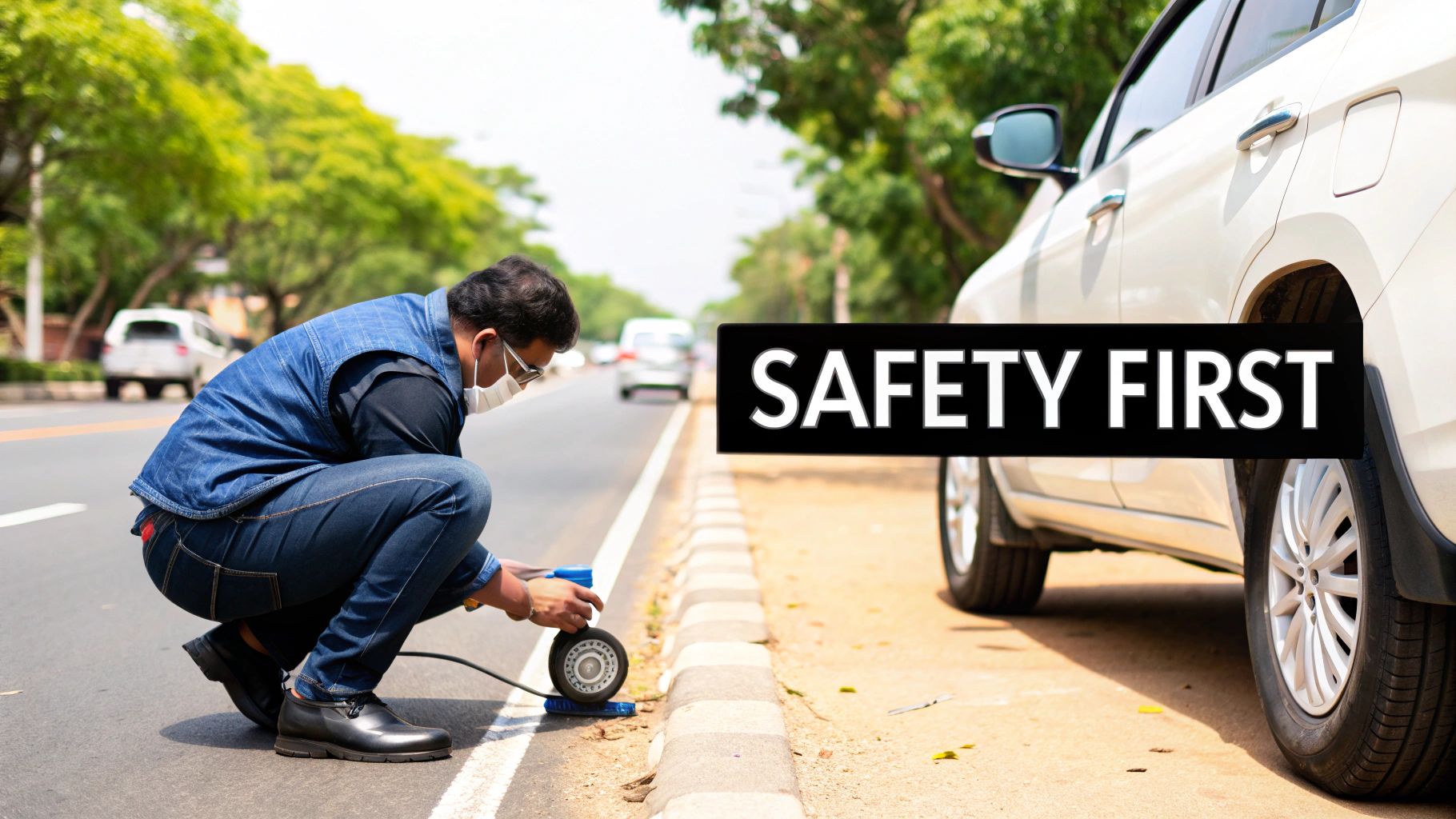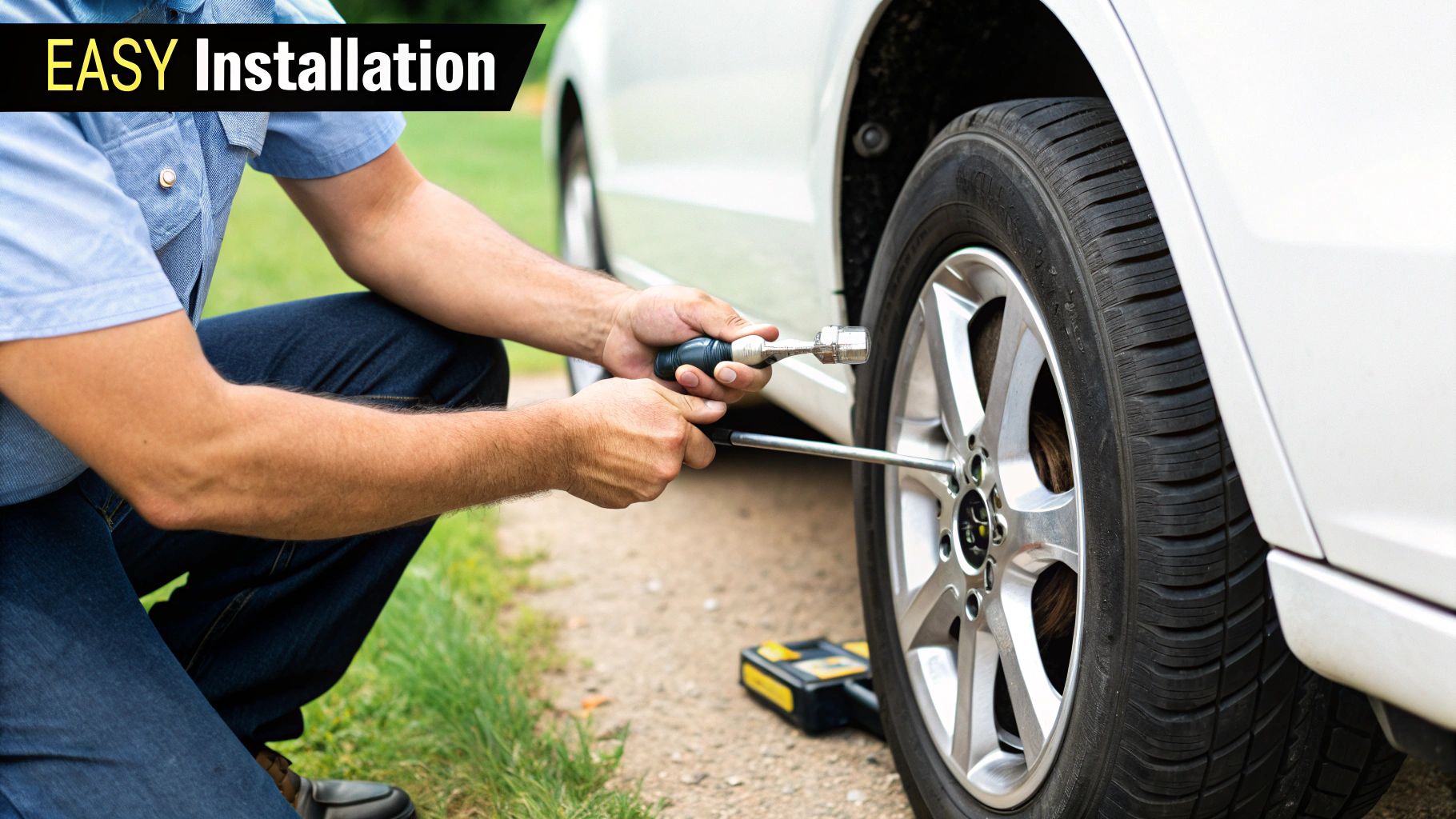Your Guide to Tyre Pressure Monitoring Systems
- coledem
- Jul 22
- 13 min read
A Tyre Pressure Monitoring System (TPMS) is like having a silent co-pilot dedicated to watching your tyres. It's an electronic system built into modern cars that keeps a constant eye on the air pressure. If it detects a significant drop in one or more tyres, a warning light pops up on your dashboard. This technology has been mandatory on all new cars sold in the UK since 2014.
Understanding Your Tyre Pressure Monitoring System

Think of it as your car's personal early-warning system. It constantly tracks the air pressure inside each tyre, which is critical for your safety and your car's performance. When that pressure falls below a safe threshold, the system triggers the dashboard icon, giving you a clear signal that something needs attention.
This isn't just a gadget for convenience; it's a key piece of safety equipment. The TPMS is your first line of defence against dangerous situations like a blowout, which can cause you to lose control of your vehicle. Keeping your tyres correctly inflated also means better handling, more responsive braking, and a more stable drive all round.
Key Functions And Purpose
The core job of a TPMS is to give you a heads-up the moment your tyre pressure drops to a dangerous level. This instant alert lets you sort out the issue before it escalates into a major safety hazard. A properly working TPMS brings a host of benefits:
Improved Road Safety: That early warning can be the difference that prevents an accident caused by tyre failure.
Better Vehicle Performance: Properly inflated tyres grip the road as they should, giving you the best stability and control.
Increased Fuel Efficiency: When your tyres are at the right pressure, there is less rolling resistance, which means your car uses less fuel.
Longer Tyre Lifespan: Driving on under-inflated tyres causes uneven wear and damage. Keeping them topped up makes them last much longer.
You can think of your TPMS like a smoke alarm for your car. It is fantastic at alerting you to immediate danger, but it does not mean you can skip your own routine safety checks.
While the TPMS is a brilliant bit of kit for flagging significant pressure loss, it does not replace the need for regular manual checks. For a simple walkthrough, take a look at our guide on **how to check tyre pressure**. Combining this smart technology with a bit of hands-on care is the best way to be safe on every trip.
Direct vs. Indirect TPMS: What's the Difference?
When that little tyre pressure warning light pings on your dashboard, it’s all thanks to your car's Tyre Pressure Monitoring System, or TPMS. But not all systems are created equal. Broadly speaking, they fall into two camps: Direct TPMS (dTPMS) and Indirect TPMS (iTPMS). Knowing which one your car uses can tell you a lot about what’s happening under the arches.
A direct system is just what it sounds like. It gets its information straight from the source. Inside each of your wheels, there's a small, battery-powered sensor, usually attached to the valve stem. This little gadget physically measures the air pressure and, in many cases, the temperature inside the tyre.
It then beams this data wirelessly to your car's brain, giving you a precise, real-time reading. Because it's a direct measurement, it's very accurate and can tell you exactly which tyre is losing air, even with a slow leak.
The Clever Alternative: Indirect TPMS
Indirect systems are a bit more cunning. Instead of adding new hardware inside the wheels, they use technology your car already has: the Anti-lock Braking System (ABS). An iTPMS does not measure air pressure at all. Instead, it cleverly watches how fast each of your wheels is spinning.
The logic is beautifully simple. A tyre that's low on air has a slightly smaller circumference than one that's properly inflated. To keep up with the other three wheels, that smaller tyre has to spin just a little bit faster. The iTPMS software picks up on this tiny difference in rotational speed, flags it as a sign of low pressure, and illuminates the warning light. It's a fantastic example of using existing systems to boost safety.
The image below breaks down the key differences between these two approaches.

As you can see, direct systems give you pinpoint accuracy, but they often come with higher maintenance costs. Indirect systems are simpler and cheaper but provide less detailed information.
Comparing Direct and Indirect TPMS
To really understand the trade-offs, it helps to see the two systems side-by-side. As a driver, you do not get to choose which system your car has—it's fitted at the factory—but knowing the pros and cons helps you manage expectations and maintenance.
Feature | Direct TPMS (dTPMS) | Indirect TPMS (iTPMS) |
|---|---|---|
How it Works | A physical sensor inside each tyre measures pressure directly. | Uses existing ABS sensors to monitor wheel rotation speed. |
Accuracy | Very high. Provides real-time pressure values (in PSI or Bar). | Lower. Triggers a general warning, does not show exact pressure. |
Tyre Identification | Can identify the specific tyre that is underinflated. | Cannot pinpoint the low tyre; you must check all four. |
Maintenance | Sensor batteries eventually die (5-10 years). Sensors can be damaged during tyre fitting and are costly to replace. | No batteries inside the tyres to worry about. Requires a manual reset after inflating tyres or a tyre rotation. |
Cost | More expensive for manufacturers to install and for owners to maintain. | Cheaper to install as it relies on existing hardware, with no extra servicing costs. |
Both systems are designed to get your attention when a tyre needs it. Knowing which type is in your car prepares you for what to expect when that warning light appears or when it's time for new tyres.
Pros and Cons of Each System
Let's boil it down to a simple list of strengths and weaknesses for each setup.
Direct TPMS (dTPMS)
Pros: Delivers highly accurate, real-time pressure readings and tells you precisely which tyre needs attention.
Cons: The sensors can be fragile and sometimes get damaged during tyre changes. Their internal batteries will also eventually run out, meaning the whole sensor unit needs replacing.
Indirect TPMS (iTPMS)
Pros: A much more cost-effective solution for car makers as it uses the existing ABS hardware. Plus, there are no sensor batteries in the wheels that will ever need replacing.
Cons: It's less precise and can't give you a specific pressure reading—just a warning that something is amiss. It also needs to be manually reset every time you top up your tyres with air or have the wheels rotated.
Whichever system your vehicle uses, a TPMS warning is your cue to check your tyres immediately. Keeping them in top condition is non-negotiable for safety. For more expert advice, check out our guide on [when to replace car tyres in the UK](https://www.krauseautos.co.uk/post/when-to-replace-car-tyres-a-uk-guide).
Why Every Modern Car in the UK Has TPMS

If you've bought a car in the last decade, you've probably noticed the tyre pressure monitoring system (TPMS) warning light. Its presence is not just a manufacturer's whim or a fancy new gadget; it's a direct result of safety laws designed to keep us all safer on the road.
The story of how TPMS became standard equipment started with growing concerns over accidents caused by unexpected tyre failures. European lawmakers realised that a simple, automated check could prevent countless incidents. So, they took action. The EU introduced legislation that made TPMS a mandatory feature in new vehicles, a move you can read more about in this overview of the global adoption of TPMS.
This rule did not happen overnight. It was rolled out in phases, but the final deadline was clear: from November 2014, every new passenger car sold across the UK and Europe had to come with a TPMS fitted as standard. It marked the moment this technology went from being a premium feature to a key safety component.
More Than a Warning Light: A Regulated Safety Feature
The TPMS mandate did not just change how cars are made; it also had a major impact on the annual MOT test. As of January 2015, a car will fail its MOT if the TPMS is not working correctly. That hammers home its importance—it’s now considered as critical to your car's safety as your brakes or seatbelts.
The thinking behind this law is very practical and focuses on two key goals:
Preventing Accidents: Under-inflated tyres are a recipe for disaster. They can lead to blowouts and a complete loss of control. A functioning TPMS gives you a key early warning, allowing you to fix the problem before it escalates into something far more dangerous.
Improving Efficiency: Tyres at the right pressure have less rolling resistance, which means your engine does not have to work as hard. The result is better fuel economy and lower CO2 emissions—a win for your wallet and the environment.
For any car registered after 2014, the TPMS is not an optional extra. It’s a legally required part of your car’s safety system, and keeping it in good working order is necessary for staying roadworthy.
This is exactly why we, and other professional garages, take TPMS servicing so seriously. It is not about just switching off a light on your dash. It’s about maintaining a government-mandated system that’s there to protect you, your passengers, and everyone else on the road.
What a Healthy TPMS Does For Your Car
A working tyre pressure monitoring system brings some very real, practical advantages to the table—advantages that are about much more than just keeping a light off your dashboard. We’re talking about tangible benefits for your safety, your wallet, and how long your tyres last.
First and foremost, it’s a massive safety feature. A seriously under-inflated tyre can make your car dangerously unstable, especially if you need to brake hard or swerve suddenly. A TPMS gives you an instant heads-up about low pressure, helping you sidestep those risky handling situations and, in a worst-case scenario, preventing a catastrophic blowout.
That early warning is your opportunity to pull over and sort out the problem before you lose control on the road.
Getting the Most From Your Fuel and Tyres
Beyond keeping you safe, a good TPMS is also a smart way to make your driving more economical. When your tyres are at the right pressure, they have less friction—or rolling resistance—as they travel along the road. This simply means your engine does not have to work as hard to push the car forward.
Maintaining the correct tyre pressure can improve your fuel efficiency by around 3-4%. Over a year of driving, that really adds up at the petrol station. It also means lower emissions, which is a nice bonus for your wallet and the environment. You can dig deeper into the numbers by reading this report on the TPMS market from Grandviewresearch.com.
A properly functioning system also has a direct impact on the lifespan of your tyres. Here’s how:
It stops uneven wear. Under-inflation forces the edges of the tyre to take all the strain, causing them to wear down much faster than the centre. The right pressure helps the entire tread wear down evenly.
It keeps them cool. Low pressure makes the tyre's sidewalls flex way too much. This flexing generates a lot of extra heat, which can break down the rubber and damage the tyre's internal structure over time.
It makes them last longer. By preventing premature and uneven wear, you can squeeze thousands of extra miles out of a set of tyres, putting off the day you need to fork out for expensive replacements.
Think of your TPMS as a silent guardian for your tyres. It’s always on duty, keeping an eye on their health and letting you know about small issues before they snowball into big, expensive, or dangerous problems.
All these benefits come back to keeping you safer on the road and cutting your running costs. That little warning light is the public face of a sophisticated system working hard to protect you and your vehicle.
Troubleshooting Common TPMS Faults

It’s that little light on the dashboard nobody wants to see. When the tyre pressure monitoring system (TPMS) warning pops up, it’s easy to jump to conclusions. But that light can mean one of two things: either you have a simple low-pressure tyre, or there's a fault in the system itself. Knowing the difference can save you a lot of hassle.
Before you panic, the first thing to do is a manual check. Grab a reliable pressure gauge and check all four tyres. Inflate them to the pressures recommended by your car's manufacturer—you’ll usually find these on a sticker inside the driver’s door frame or in the owner's manual. A lot of the time, this simple fix is all it takes for the light to turn off after a few minutes of driving.
But what if the light stays on even after you’ve double-checked the pressures? That’s a strong clue that the problem runs a little deeper and the system itself needs looking at.
Identifying the Source of a System Fault
When a quick air top-up does not do the trick, it’s a safe bet the TPMS itself has a problem. Several common issues can trigger a fault alert, stopping the system from doing its job.
Getting these problems sorted is crucial, especially since a faulty TPMS is an automatic MOT failure. We cover this and other common pitfalls in our guide on the top reasons why cars fail their MOT test.
So, what usually goes wrong? Here are the most frequent culprits:
Dead Sensor Battery: Direct TPMS sensors each have a tiny, sealed battery. They last a good while, typically around 5-7 years, but once they die, the sensor goes offline and triggers the fault light.
Sensor Damage: Because they live inside the wheel, sensors are vulnerable. A nasty pothole or even a clumsy tyre change can easily damage or break one.
Signal Interference: It's rare, but sometimes other electronics can interfere with the radio signals the sensors send to the car's computer, causing a communication breakdown.
Programming Errors: When you get new tyres or replace a sensor, the system needs to be told to recognise the new component. If this "re-learning" process is not done correctly, it will report a fault.
Pro Tip: Pay attention to how the light behaves. A solid, steady TPMS light usually means low pressure. But if it flashes for a minute or so before staying on, that’s the system telling you it has a fault and can't monitor your tyres anymore.
When to Seek Professional Help
For simple resets after topping up the air, you might be able to handle it yourself. Many cars have a reset button or a sequence you can follow in the infotainment menu—your owner's manual will have the details.
For anything more complicated, you will need a professional. At the garage, we use diagnostic tools to communicate directly with your car's onboard computer. This gives us specific fault codes that pinpoint exactly which sensor is playing up or what the error is. From there, we can replace a sensor, sort out the programming, and get your tyre pressure monitoring system back in working order, keeping you safe and your car road-legal.
Professional TPMS Servicing and Maintenance
While your TPMS is designed to be a low-maintenance safety feature, it is not entirely "set and forget." To keep it running reliably, it needs a bit of expert attention during regular car servicing, especially if you have a direct TPMS with its battery-powered sensors.
Think of those sensors like the batteries in a smoke detector—they do not last forever. Typically, you can expect a lifespan of 5 to 7 years before the internal battery gives out. When that happens, the sensor goes silent, triggering a fault light on your dash and leaving that tyre unmonitored.
The Role of Professional Diagnostics
So, what do you do when the TPMS light comes on and stays on, even after you've checked and corrected your tyre pressures? It's time to call in the professionals. At a good garage, mechanics use specialised diagnostic tools that plug into your car's computer and speak its language.
This scan pinpoints the exact problem by reading the specific TPMS fault codes. These codes tell the technician precisely which sensor has failed or whether there's a different issue, like a communication breakdown between the sensor and the car. It completely removes the guesswork, saving you both time and money.
It’s a good idea to remember that TPMS sensors are surprisingly delicate. A common cause of faults is accidental damage during a routine tyre change or wheel rotation, so it pays to use a technician who knows how to handle them carefully.
Once the problem is identified, a technician can get to work. The fix usually involves one of a few things:
Replacing a failed sensor: This means carefully removing the old unit from the wheel and fitting a brand-new one.
Servicing the valve stems: For direct systems, it's good practice to replace the valve core, cap, and seals during a tyre change to prevent corrosion and slow leaks.
Reprogramming the system: A new sensor needs to be properly introduced to your car’s computer. This quick reprogramming step helps it communicate with the vehicle, getting your TPMS back online and protecting you again.
Choosing a local garage with the right tools and expertise makes all the difference in sorting these issues out quickly and correctly. You can read more about the **top benefits of local garages for everyday drivers** in our guide. With regular checks and servicing when needed, your tyre pressure monitoring system will remain a dependable safety net for years.
Your TPMS Questions Answered
It’s one of those warning lights everyone dreads seeing pop up on their dashboard. If you've got questions about your tyre pressure monitoring system, you're not alone. Let's run through some of the most common queries we hear from drivers.
Is It Safe to Keep Driving if the TPMS Light Comes On?
Honestly, it’s not a good idea. That little light is your car's way of telling you something needs attention, and ignoring it is a gamble.
If the light is on and stays on, that's a classic sign that one or more of your tyres is low on air. You should find a safe place to pull over, give your tyres a visual check, and get them inflated to the correct pressure as soon as you can.
A flashing light is a different beast altogether. That usually signals a problem with the TPMS itself—maybe a dead battery in a sensor or a communication fault. Either way, solid or flashing, that light is a warning that your car's safety, fuel efficiency, and tyre lifespan are at risk. It is always best to get it sorted out quickly.
How Do I Reset the Tyre Pressure Light?
The reset process for a tyre pressure monitoring system can be wildly different from one car to the next. Some cars make it easy with a physical TPMS reset button, often tucked away in the glove box or on the dash near your right knee.
In most newer vehicles, you'll have to go into the car's settings menu on the infotainment display. The crucial first step, no matter the car, is to confirm all your tyres are inflated to the pressure recommended by the manufacturer (you'll find this on a sticker inside the driver's door jamb). After that, your owner's manual is your best friend—it will have the specific step-by-step guide to get the system recalibrated properly.
Always check your vehicle's handbook for the exact reset instructions. Guessing or following a generic guide can stop the system from recalibrating correctly, leaving you stuck with that warning light.
Does the TPMS Warning Light Automatically Mean a Puncture?
Not always, but it's a definite possibility. The TPMS light is simply an alert for low pressure; a puncture is just one of the reasons that can happen. Tyres lose a little bit of air naturally over time, and a sudden cold snap can also be a trigger.
When the temperature drops, the air inside your tyres contracts, which lowers the pressure. It’s why we see a flood of TPMS lights flick on during the first cold mornings of autumn. But if you find you're constantly topping up the same tyre week after week, you've almost certainly got a slow puncture on your hands and it's time for a professional inspection.
For any issues with your tyre pressure monitoring system, from a quick diagnosis to a full sensor replacement, the expert team at Krause Autos is here to help. Contact us today for reliable TPMS servicing in Sandy and the surrounding Bedfordshire area.


Comentarios